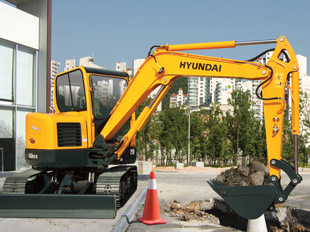Compact radius excavators have evolved to tackle confined jobsite demands without sacrificing power.
More and more operators are recognizing the versatility and productivity of compact radius excavators. These excavators have a reduced- or zero-tail swing so operators can work on jobsites where standard excavators with prominent counterweights can’t fit, such as urban areas and road construction.
 Most manufacturers will offer these machines in a wide range of horsepower and operating weights depending on the project. It’s important to know the use of the machine and find a piece of equipment that gives you the digging performance or lifting capacity you need within the space of the jobsite.
Most manufacturers will offer these machines in a wide range of horsepower and operating weights depending on the project. It’s important to know the use of the machine and find a piece of equipment that gives you the digging performance or lifting capacity you need within the space of the jobsite.
Compact Radius Excavator Vs. Mini Excavator
Sometimes there is confusion of the differences between a mini excavator and a compact radius excavator, but a great deal of difference exists between the two types of equipment. For example, these are the most common differences:
The compact radius excavator is actually a full-size excavator that has been compacted into a smaller, tighter package. It has a shorter undercarriage assembly and a greatly reduced overhang of the counterweight area. The compact radius excavator is rated with the same power, output, and reach as the standard excavator, only with a smaller footprint.
Mini excavators come in two types: mini and zero-tail swing. A mini excavator has counterweight overhang like full-size machines, only in a much smaller package. Zero-tail swings are built like the compact radius machines, everything pulled in as tight as possible in a very small package.
Mini compact radius excavators with zero-tail swing can be operated efficiently on jobsites where space is tight, such as near walls or residential projects, and are ideal for landscaping and light construction jobs. Full-size compact radius excavators with a tight tail swing radius provide less weight and improved maneuverability. They are good for light construction, utility, demolition, landscaping and other applications where space is limited but power is needed.
Adding Attachments
Adding an attachment can make a compact radius excavator even more versatile while increasing the available space on a confined jobsite. In many cases, attaching a dozer blade can eliminate the need for a dozer on a jobsite. Dozer attachments are excellent for backfilling and light-duty blade work. With numerous attachments available, you are limited only by your imagination. Thumbs, compactors, drills, breakers, cutters and augers are only a few of the attachments available for these machines. Once a compact radius excavator is equipped with an attachment, the applications are limitless: pipe laying, irrigation, landscaping, plumbing, hard-scape, demolition, etc.
Important Purchasing Considerations
With so many choices on the market, purchasing a new compact radius excavator can be intimidating. Most machines are going to be very similar on the spec. charts because many manufacturers use the same parts suppliers. Small details are often deciding factors on new machine purchases: warranties, parts availability, after-sales support, price and dealer networks. Manufacturing companies are constantly changing machines to meet market demands and stand apart from the crowd. Extended warranties, multiple power modes, satellite communication systems and computerized fleet maintenance systems are some of the new ways that OEMs are offering customers a better dollar value.
Convenience and comfort of the operator also are important differentiating factors between machines. Keep an eye out for value-adding features like fully adjustable seats and armrests, large-foot pedals, ergonomic joysticks, storage space, LCD monitor control, safety glass and automatic climate control. When examining the various lines available, look for models where these features and benefits come standard.
Used Vs. New
Buying used equipment is like buying used cars—sometimes you get burned. It is difficult to quantify how a machine has been operated and maintained. Walk around the machine, and stop, look and listen to get a good idea of its condition. Look for signs of abuse and misuse, such as dents, scrapes, oil leaks and missing parts. Listen for unusual noise when operating the machine (engine, hydraulic pump, swing motor, travel motors, etc.). Some used machines may come with an extended warranty. It is also a good idea to check hydraulic system pressures and compare with new machine specs.
Maintenance Concerns
Once you’ve purchased your compact radius excavator, it’s never too soon to start thinking about maintenance. Reading the operators manual cover-to-cover is a great first step and worth the time. The operators manual is filled with service information for the machine, such as maintenance schedules and recommended lubricants. Routine maintenance like changing oils and filters and keeping the cooling system clean of dirt and debris will do wonders for the life and health of your compact radius excavator.
Operational Safety
When instructing crews on how to operate a compact radius excavator, emphasize the importance of their awareness of surroundings because they will most likely be working in confined areas. Power lines, gas meters, power meters, overhanging eaves, swimming pools, sidewalks, patios and fences are just some of the obstructions seen on jobsites where these machines are used. The bottom line is to use common sense and know your machine’s limitations. These smaller machines are highly capable and versatile when used properly.
As long as there are confined jobsites in construction, contractors will need specialized compact radius excavators. With the state of today’s economy, heavy equipment owners and operators will continue to demand better fuel use for their dollar. Tier 4i engines now being put into construction equipment are designed for much better fuel economy.
Just as automobiles have evolved, these machines will continue to change into more efficient and productive tools.
